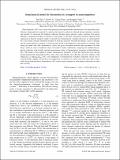Semiclassical model for thermoelectric transport in nanocomposites
Author(s)
Zhou, Jun; Li, Xiaobo; Chen, Gang; Yang, Ronggui
DownloadZhou-2010-Semiclassical model.pdf (1.437Mb)
PUBLISHER_POLICY
Publisher Policy
Article is made available in accordance with the publisher's policy and may be subject to US copyright law. Please refer to the publisher's site for terms of use.
Terms of use
Metadata
Show full item recordAbstract
Nanocomposites (NCs) has recently been proposed and experimentally demonstrated to be potentially high-efficiency thermoelectric materials by reducing the thermal conductivity through phonon-interface scattering and possibly by increasing the Seebeck coefficient through energy-selective carrier scattering (low-energy filtering) or quantum-size effect of electrons. In this paper, we develop a Boltzmann transport equation based semiclassical electron transport model to describe the thermoelectric transport processes in semiconductor NCs. This model considers multiband transport of electrons and holes with both the intrinsic carrier scatterings and the carrier-interface scattering. A relaxation-time model is developed for carrier-interface scattering. After fitting the model with bulk thermoelectric alloys that gives reasonable material input parameters for bulk alloys, which are close to handbook values, the model is further validated by comparing the modeled thermoelectric properties with recently reported measurement values of thermoelectric properties in high efficiency NCs. The model is then applied to predict thermoelectric properties of both the particle-host-type and the particle-particle-type semiconductor NCs such as the p-type (Bi[subscript y]Sb[subscript 2-y]Te[subscript 3])-(Bi[subscript 0.5]Sb[subscript 1.5]Te[subscript 3]) NCs and the n-type (Mg[subscript 2]Si[subscript y]Ge[subscript 1-y])-(Mg[subscript 2]Si[subscript 0.6]Ge[subscript 0.4]) NCs. The dependence of thermoelectric transport coefficients on the size of nanoconstituent, doping concentration and temperature are studied. Our study could shed some light to optimally design high-efficiency thermoelectric NCs which could contribute to solar-thermal utilization or waste heat recovery.
Date issued
2010-09Department
Massachusetts Institute of Technology. Department of Mechanical EngineeringJournal
Physical Review B
Publisher
American Physical Society
Citation
Zhou, Jun et al. "." Physical Review B 82.15 (2010): 115308. © 2010 The American Physical Society
Version: Final published version
ISSN
1098-0121
1550-235X